八年级英语上册 语法 形容词副词比较级最高级特殊用法作业 (新版)人教新目标版
- 格式:doc
- 大小:29.00 KB
- 文档页数:2

形容词复习第一课时学习目标:掌握形容词的定义、位置及用法,并能熟练运用到考试中。
学习重、难点:形容词的位置及用法的熟练掌握学习过程:一、课前准备观察下面的单词:short tall beautiful thin kind big bright earnest gentle longsmall sunny hard-working honest generous careful careless efficient以上单词都是用来修饰名词或代词,表示人或物的性质、特征或状态的词,我们把它们称为形容词,用符号adj.来表示。
二、讨论交流(课堂)(一)形容词的用法1. 形容词可以作定语。
一般词序为“冠词(或其他限定词)+ 形容词+名词”①This is a difficult question.这是一个困难的问题。
(difficult 是形容词,做定语,修饰名词question)②There are some beautiful flowers in the garden.花园里有一些美丽的花。
(beautiful 是形容词,做定语,修饰名词flowers)2. 形容词可以作表语。
通常用在be , keep, get, become, turn, stay, seem, look, taste, sound, feel, smell, appear等连系动词之后作表语。
例如:① I think this story is very interesting.我认为这个故事很有趣。
(interesting做表语)② He looks sad.他看上去很悲伤。
(sad 做表语)③We should keep healthy.我们应该保持健康。
(healthy 做表语)④This piece of music sounds very beautiful.这首音乐听起来很优美。
(beautiful做表语)3. 形容词可以作宾语补足语① Rainy days make me sad.下雨的日子使我忧愁。

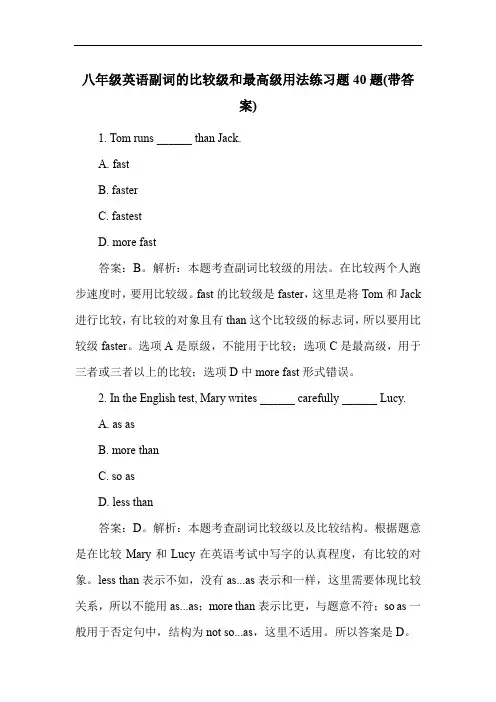
八年级英语副词的比较级和最高级用法练习题40题(带答案)1. Tom runs ______ than Jack.A. fastB. fasterC. fastestD. more fast答案:B。
解析:本题考查副词比较级的用法。
在比较两个人跑步速度时,要用比较级。
fast的比较级是faster,这里是将Tom和Jack 进行比较,有比较的对象且有than这个比较级的标志词,所以要用比较级faster。
选项A是原级,不能用于比较;选项C是最高级,用于三者或三者以上的比较;选项D中more fast形式错误。
2. In the English test, Mary writes ______ carefully ______ Lucy.A. as asB. more thanC. so asD. less than答案:D。
解析:本题考查副词比较级以及比较结构。
根据题意是在比较Mary和Lucy在英语考试中写字的认真程度,有比较的对象。
less than表示不如,没有as...as表示和一样,这里需要体现比较关系,所以不能用as...as;more than表示比更,与题意不符;so as一般用于否定句中,结构为not so...as,这里不适用。
所以答案是D。
3. When we do sports, John jumps ______ high ______ all of us.A. higher thanB. highest ofC. high amongD. more high than答案:A。
解析:本题考查副词比较级。
比较John和我们所有人跳高的高度,是两者之间的比较,要用比较级。
high的比较级是higher,比较级后面接than表示比,highest是最高级,用于三者或三者以上比较,more high形式错误,high among这种表达不符合比较级的语法规则。
所以答案是A。
4. In the reading class, Lily reads ______ quickly ______ her deskmate.A. as quickly asB. more quickly thatC. quickly thanD. the most quickly than答案:A。
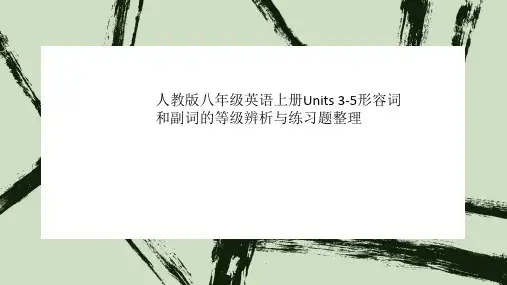

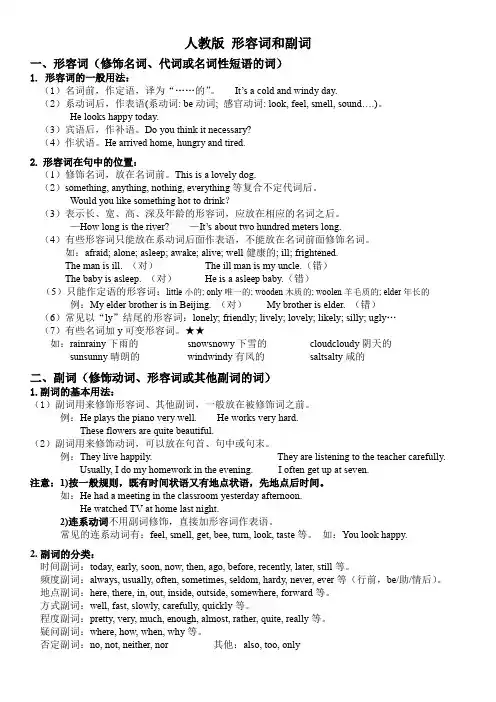
人教版形容词和副词一、形容词(修饰名词、代词或名词性短语的词)1.形容词的一般用法:(1)名词前,作定语,译为“……的”。
It’s a cold and windy day.(2)系动词后,作表语(系动词: be动词; 感官动词: look, feel, smell, sound….)。
He looks happy today.(3)宾语后,作补语。
Do you think it necessary?(4)作状语。
He arrived home, hungry and tired.2.形容词在句中的位置:(1)修饰名词,放在名词前。
This is a lovely dog.(2)something, anything, nothing, everything等复合不定代词后。
Would you like something hot to drink?(3)表示长、宽、高、深及年龄的形容词,应放在相应的名词之后。
—How long is the river? —It’s about two hundred meters long.(4)有些形容词只能放在系动词后面作表语,不能放在名词前面修饰名词。
如:afraid; alone; asleep; awake; alive; well健康的; ill; frightened.The man is ill. (对)The ill man is my uncle.(错)The baby is asleep. (对)He is a asleep baby.(错)(5)只能作定语的形容词:little小的; only唯一的; wooden木质的; woolen羊毛质的; elder年长的例:My elder brother is in Beijing. (对)My brother is elder. (错)(6)常见以“ly”结尾的形容词:lonely; friendly; lively; lovely; likely; silly; ugly…(7)有些名词加y可变形容词。
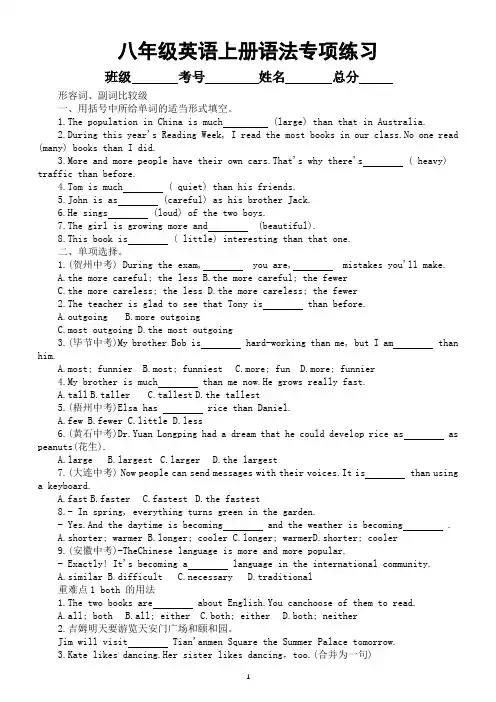
八年级英语上册语法专项练习班级考号姓名总分形容词、副词比较级一、用括号中所给单词的适当形式填空。
1.The population in China is much (large) than that in Australia.2.During this year's Reading Week, I read the most books in our class.No one read (many) books than I did.3.More and more people have their own cars.That's why there's ( heavy)traffic than before.4.Tom is much ( quiet) than his friends.5.John is as (careful) as his brother Jack.6.He sings (loud) of the two boys.7.The girl is growing more and (beautiful).8.This book is ( little) interesting than that one.二、单项选择。
1.(贺州中考) During the exam, you are, mistakes you'll make.A.the more careful; the lessB.the more careful; the fewerC.the more careless; the lessD.the more careless; the fewer2.The teacher is glad to see that Tony is than before.A.outgoingB.more outgoingC.most outgoingD.the most outgoing3.(毕节中考)My brother Bob is hard-working than me, but I am thanhim.A.most; funnierB.most; funniestC.more; funD.more; funnier4.My brother is much than me now.He grows really fast.A.tallB.tallerC.tallestD.the tallest5.(梧州中考)Elsa has rice than Daniel.A.fewB.fewerC.littleD.less6.(黄石中考)Dr.Yuan Longping had a dream that he could develop rice as as peanuts(花生).rgergestrgerD.the largest7.(大连中考) Now people can send messages with their voices.It is than usinga keyboard.A.fastB.fasterC.fastestD.the fastest8.- In spring, everything turns green in the garden.- Yes.And the daytime is becoming and the weather is becoming .A.shorter; warmerB.longer; coolerC.longer; warmerD.shorter; cooler9.(安徽中考)-TheChinese language is more and more popular.- Exactly! It's becoming a language in the international community.A.similarB.difficultC.necessaryD.traditional重难点1 both 的用法1.The two books are about English.You canchoose of them to read.A.all; bothB.all; eitherC.both; eitherD.both; neither2.吉姆明天要游览天安门广场和颐和园。
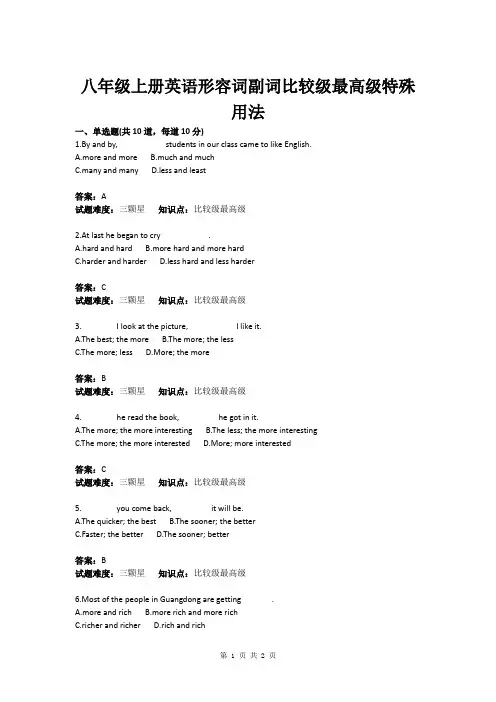
八年级上册英语形容词副词比较级最高级特殊用法一、单选题(共10道,每道10分)1.By and by, students in our class came to like English.A.more and moreB.much and muchC.many and manyD.less and least答案:A试题难度:三颗星知识点:比较级最高级2.At last he began to cry .A.hard and hardB.more hard and more hardC.harder and harderD.less hard and less harder答案:C试题难度:三颗星知识点:比较级最高级3. I look at the picture, I like it.A.The best; the moreB.The more; the lessC.The more; lessD.More; the more答案:B试题难度:三颗星知识点:比较级最高级4. he read the book, he got in it.A.The more; the more interestingB.The less; the more interestingC.The more; the more interestedD.More; more interested答案:C试题难度:三颗星知识点:比较级最高级5. you come back, it will be.A.The quicker; the bestB.The sooner; the betterC.Faster; the betterD.The sooner; better答案:B试题难度:三颗星知识点:比较级最高级6.Most of the people in Guangdong are getting .A.more and richB.more rich and more richC.richer and richerD.rich and rich答案:C试题难度:三颗星知识点:比较级最高级7.Water pollution is one of in our country.A.serious problemB.the more serious problemsC.most serious problemsD.the most serious problems答案:D试题难度:三颗星知识点:比较级最高级8.Canada is the second country in this area.A.strongB.strongestC.strongerD.the strongest答案:B试题难度:三颗星知识点:比较级最高级9.Tony is one of in our class.A.the tallest boyB.the tallest boysC.the taller boyD.the taller boys答案:B试题难度:三颗星知识点:比较级最高级10.This river is the second river in this village.A.longerB.longC.longestD.longger答案:C试题难度:三颗星知识点:比较级最高级。
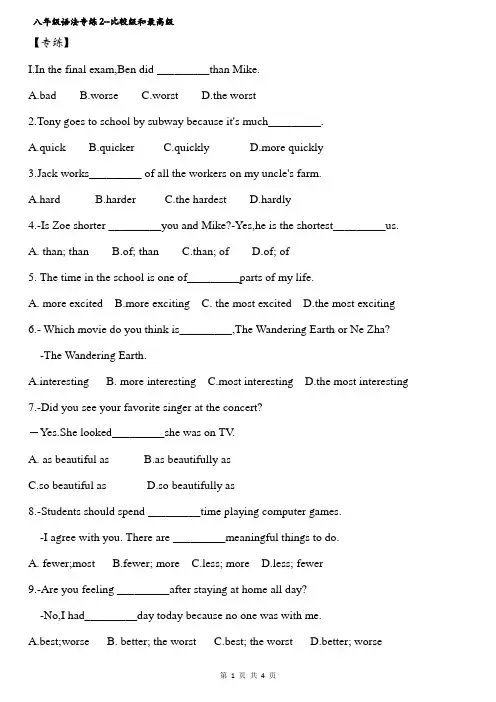
【专练】I.In the final exam,Ben did _________than Mike.A.badB.worseC.worstD.the worst2.Tony goes to school by subway because it's much_________.A.quickB.quickerC.quicklyD.more quickly3.Jack works_________ of all the workers on my uncle's farm.A.hardB.harderC.the hardestD.hardly4.-Is Zoe shorter _________you and Mike?-Yes,he is the shortest_________us.A. than; thanB.of; thanC.than; ofD.of; of5. The time in the school is one of_________parts of my life.A. more excitedB.more excitingC. the most excitedD.the most exciting6.- Which movie do you think is_________,The Wandering Earth or Ne Zha?-The Wandering Earth.A.interestingB. more interestingC.most interestingD.the most interesting7.-Did you see your favorite singer at the concert?-Yes.She looked_________she was on TV.A. as beautiful asB.as beautifully asC.so beautiful asD.so beautifully as8.-Students should spend _________time playing computer games.-I agree with you. There are _________meaningful things to do.A. fewer;mostB.fewer; moreC.less; moreD.less; fewer9.-Are you feeling _________after staying at home all day?-No,I had_________day today because no one was with me.A.best;worseB. better; the worstC.best; the worstD.better; worse10. Kate is _________than any other student in my class so she is also_________one.A. the most outgoing; the most popularB. the most outgoing; more popularC. more outgoing; the most popularD.more outgoing; more popularII.根据句意,用所给单词的适当形式填空。
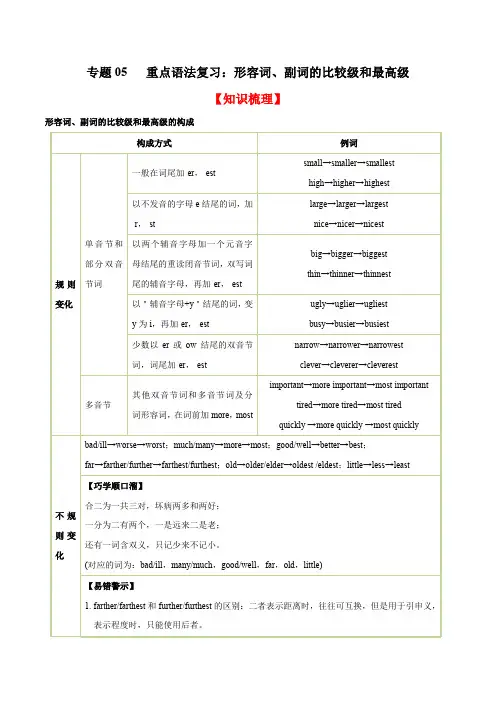
专题05 重点语法复习:形容词、副词的比较级和最高级【知识梳理】形容词、副词的比较级和最高级的构成考向二形容词比较等级的句式结构和用法【专题过关】一、单项选择1.—There will be ________ space for wildlife in the world if we do nothing.—Don’t worry. Our government are doing something to prevent it.A.more and more B.less and less C.bigger and bigger D.smaller and smaller 2.— What do you think of the book The Secret Garden?— Perfect. I have never read a ________ one before.A.worse B.worst C.better D.best 3.—Which team will win the basketball match, the Lakers or the Rockets?—The Lakers, I think. Because it is ________ of the two teams.A.stronger B.strong C.the strongest D.the stronger 4.—Many actors are in My People, My Country. Who do you think act ________?—Of course Mr. Huang. We can’t find ________ one.A.better; a best B.a better; best C.best; a better5.Shanghai is a ________ city than Tianjin.A.busily B.busy C.busier D.more busily6.—What is ________ river in China?—The Changjiang River.A.long B.longer C.much longer D.the longest7.It is known that January is ________ month of the year in Shenyang.A.cold B.colder C.much colder D.the coldest8.—Would you like a banana milk shake?—Sure! That’s one of ________ drinks I enjoy.A.good B.better C.the best D.best9.Which cartoon hero do you think is ________, Nezha, Monkey King, or Pleasant Goat?A.smart B.smarter C.smartest D.the smartest10.Shanghai is one of ________ in the world.A.the biggest cities B.the biggest city C.the most biggest city11.Tara spoke ________ than the other speakers, so we could hardly hear her.A.more quietly B.most quietly C.more loudly D.most loudly12.—Who got better grades in the exam, Dale or Alex?—Dale. He wrote ________ him.A.less beautifully than B.as beautifully as C.more beautifully than13.—Who sang ________ in the competition, Ben or Robert?—Ben, I think. But Robert’s voice (嗓音) sounded ________.A.clearer, comfortably B.more clearer, more comfortablyC.more clearly, more comfortable D.clearer, more comfortably14.—Who got better grades in the exam, Dale or Alex?—Dale. He wrote ________ Alex.A.as beautiful as B.as beautifully as C.more beautiful than D.more beautifully than15.No Poverty Land shows the changes in some poor areas in China. This TV program has gotten ________ peopleto know China ________ and won lots of good reviews (评价) online.A.fewer, worse B.more, better C.fewer, better16.I think Linda does her homework ________ of us.A.careful B.more carefullyC.the most carefully D.the most careful17.Of all the mountains, Qomolangma rises ________ and is ________.A.higher, more famous B.highest, most famous C.the highest, the most famous 18.Lily ran in the race, so she got the first prize at last.A.quickly B.more quickly C.the most quickly19.Of all the students in Class 3, Sarah came to school ________ this morning.A.early B.earlier C.earliest D.the earlier20.Of all the students in Class Three, Tim runs ________.A.fast B.faster C.more faster D.the fastest 21.— Who ran ________ of all in the sports meeting?—Hector did, I think.A.fast B.faster C.fastest D.most fast 22.Julie won first prize in the singing competition because she sang________of all the singers. A.well B.best C.badly D.worst23.Of the three boys over there, John sings English songs ________.A.more beautiful B.the most beautifulC.more beautifully D.the most beautifully24.— How beautifully Betty sings! Does she often win the singing competitions?— Yes, she does. I cannot think of anyone with ________.A.the best voice B.the worst voice C.a better voice D.a worse voice 25.I like this one because it looks so cool and it is much ________ than the others.A.more cheaper B.more expensive C.cheaper D.expensive 26.Lucy thinks maths is ________ than Chinese.A.easy B.easier C.the easiest D.easily27.It’s too noisy here. I need a ________ place to study in.A.cleaner B.quieter C.safer D.smaller 28.—Do you know that China is one of ________countries in the world?—Yes, I do. It’s________than the USA.A.more oldest ; much older B.the oldest ; much older C.the oldest ; more older 29.—I think Cindy is __________ student in our class.—I don't think so. Linda is ___________ than her.A.smarter; smarter B.smarter; the smartestC.the smartest; the smartest D.the smartest; smarter30.My brother is only15 years old, but he is _________ in our family.A.tall B.taller C.tallest D.the tallest二、完成句子31.现在越来越多的鸟儿因为没有足够的生存空间而处于危险当中。
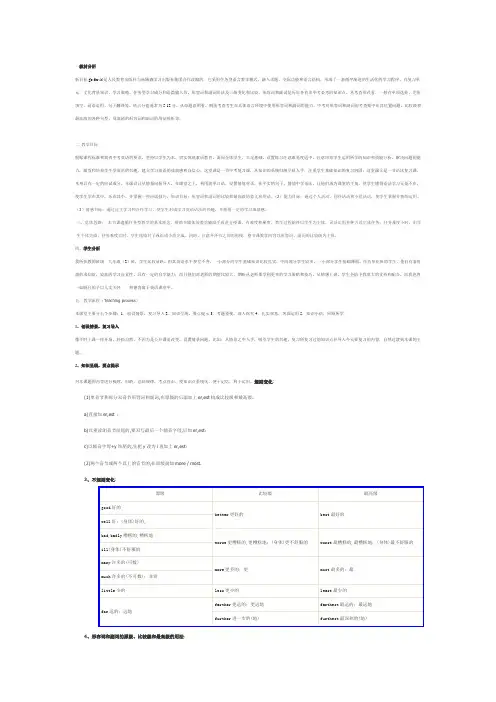
一教材分析新目标go for it!是人民教育出版社与汤姆森学习出版社集团合作改编的。
它采用任务型语言教学模式,融入话题、交际功能和语言结构,形成了一套循序渐进的生活化的学习程序。
有复习单元、文化背景知识、学习策略、任务型学习成分和语篇输入等。
形容词和副词用法及三级变化和比较。
形容词和副词是历年各省市中考必考的知识点。
从考查形式看,一般有单项选择、完形填空、词语运用、句子翻译等。
所占分值通常为5-12分。
从命题意图看,侧重考查考生在具体语言环境中使用形容词和副词的能力。
中考对形容词和副词的考查集中在其位置问题、比较级和最高级的各种句型、易混淆的形容词和副词的用法辨析等。
二教学目标根据课程标准和我省中考英语的要求。
坚持以学生为本,切实体现素质教育,面向全体学生,立足基础,设置练习注意难易度适中,注意培养学生运用所学的知识和技能分析、解决问题的能力,激发和培养学生学英语的兴趣,建立学习英语的成就感和自信心。
这堂课是一节中考复习课,从知识的系统归纳呈现入手,注重学生基础知识的复习巩固;这堂课又是一节语法复习课,本身具有一定的应试成分。
本课设计从情景问候导入,在课堂之上,利用简单口语,设置情境对话,在平实的句子,情境中学语法,让他们成为课堂的主角,使学生懂得语法学习无处不在,使学生学在其中,乐在其中。
并掌握一些应试技巧。
知识目标:形容词和副词的比较和最高级的意义和用法。
(2)能力目标:通过个人活动,同伴活动和小组活动,使学生掌握并熟练运用。
(3)情感目标:通过自主学习和合作学习,使学生形成学习英语语法的兴趣,并获得一定的学习成就感。
三、总体思路:本节课遵循任务型教学的基本理念,借助多媒体等教学辅助手段进行授课,有难度和梯度,教学过程始终以学生为主体,灵活运用多种方式完成任务:任务难度小时,由学生个体完成,任务难度大时,学生结成对子或组成小组完成。
同时,注意各环节之间的衔接。
整节课教学内容以形容词、副词的比较级为主体。
.
精品
形容词副词比较级最高级特殊用法(作业)
一、选择题
( )1. The garden is becoming .
A.more beautiful and more B.more
beautiful and beautiful C.more and
more beautiful D.more beautiful and
beautifuler
( )2. They competed(比赛) to see who could work .
A.the fastest and fast B.the fastest and fastest
C.fastest and fast D.faster and faster
( )3. hurry, speed.
A.More;less B.Much;little
C.The more;the less D.The much;the little
( )4. The Yellow River is the second
country.
A.long B.longer
C.longest D.the longest
river in our
( )5. children there are in family, their life will be. A.The less;the
better B.The fewer;the better C.Fewer;richer D.More;
poorer
( )6. India has the second population in the world.
A.larger B.most C.smallest D.largest
( )7. Beijing is one of cities in China.
A.very beautiful B.much beautiful
C.more beautiful D.the most beautiful
二、填空题
1. 她的身体状况一天天好起来。
He is getting every day.
2. 他对英语越来越感兴趣。
He is becoming
3. 他吃的越多,人越胖。
The more he eats,the _ he gets.
English.
.
精品
【参考答案】
一、选择题
1-5 CDCCB 6-7DD
二、填空题
1.better and better
2.more and more interested in
3.fatter
如有侵权请联系告知删除,感谢你们的配合!